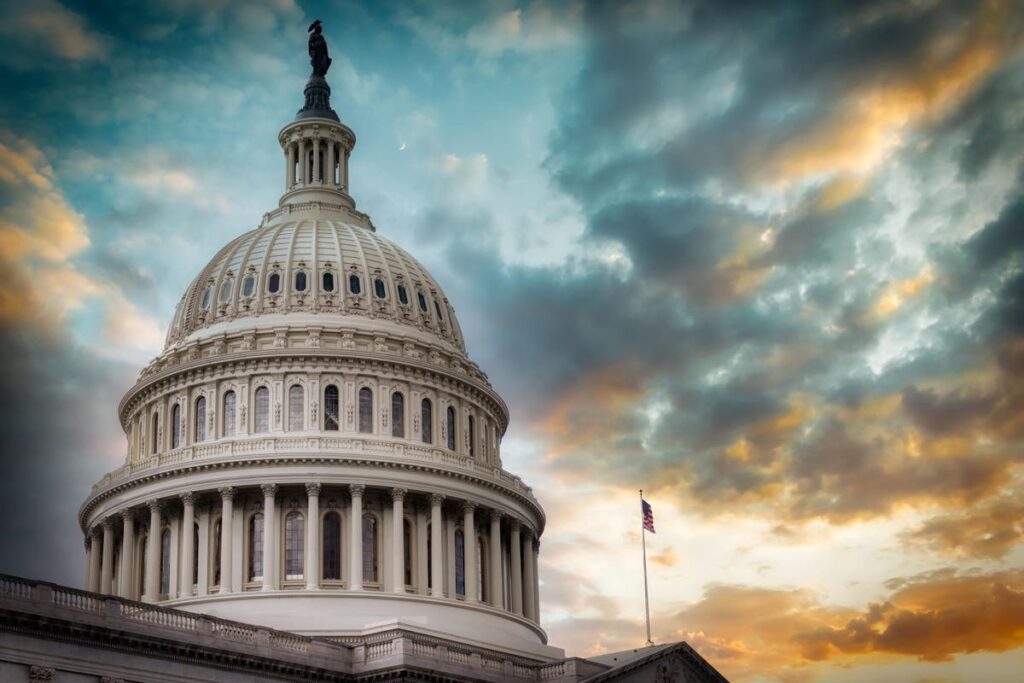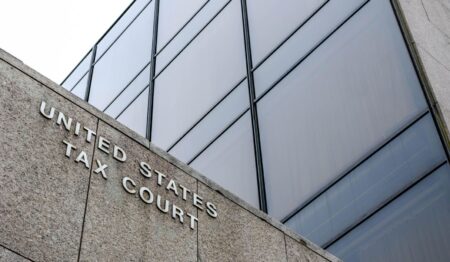What’s the return on new money spent for tax enforcement? Over the years, the IRS has answered that question with a range of estimates: 7 to 1, 9 to 1, 11 to 1. During a particularly bitter 1947 debate, the Truman administration insisted on a 20-1 ratio.
But Congress was having none of it. After their victory in the 1946 midterm elections, Republicans set about slashing the federal budget. Driven by a mixture of conviction and partisan impulse, leaders of the new GOP majorities on Capitol Hill tried to force major spending cuts on President Harry Truman.
Almost no government function got a pass: Even defense spending got a haircut, despite the advent of a new Cold War. But Republican leaders were especially keen to cut spending at the Bureau of Internal Revenue (BIR).
Then, as now, the agency was an easy target for ambitious politicians. Moreover, its sheer size encouraged complaints that it was bloated and inefficient. Republican fiscal hawks were ready to demand some serious belt-tightening.
House Cuts
On March 7, 1947, the House Appropriations Committee approved the first of its spending bills for fiscal 1948. The measure, providing money for both the Treasury Department and the Post Office, featured a one-third cut in overall spending.
Almost all of that reduction came from the Treasury budget — and from BIR funding in particular, which lawmakers targeted for a $30 million reduction. The scale of the proposed cut was both shocking and predictable.
Leaders of the House majority — the GOP’s first since 1933 — had made no secret of their plans to scale back Treasury spending. But Treasury officials insisted that a $30 million reduction would be devastating.
Truman’s 1948 budget proposal had already pared spending to the bone, Treasury Secretary John W. Snyder insisted in testimony before the Appropriations Committee. “It is my honest belief that the appropriation which we are asking for this year is the smallest amount upon which the Treasury Department can operate efficiently,” he said during January 1947 hearings. “Any cut would result in a greater loss to the government and to the country than the amount saved,” Snyder warned.
This sort of defensive posture has always been popular with Cabinet secretaries trying to deflect the budgetary ax. But Snyder was especially vigorous and specific when trying to defend his $208 million budget request for the BIR.
The tax agency had grown dramatically during World War II, Snyder contended, reflecting the transformation of the income tax from a narrow levy on the rich to a mass tax on almost every working American.
The number of individual tax returns filed annually had increased ninefold, from roughly 8 million in 1939 to 48.5 million in 1945. The increased workload had driven simultaneous growth in agency funding, especially for compliance functions.
After the end of the war, the BIR’s workload had not diminished. In fact, it had increased, as the agency struggled to clear a backlog of cases.
The bottom line, according to Snyder: The agency could not afford major reductions in its fiscal 1948 budget. To bolster his case, Snyder insisted that money spent on BIR operations should be viewed as an investment — and a good one at that.
“A year and a half ago, you may remember that the Treasury asked your committee for authority to accelerate an enforcement program to curb tax evasion,” Snyder said.
The resulting budget increase had boosted tax assessments by $1.3 billion in fiscal 1946. In 1947 Treasury expected that number to rise to $1.8 billion. And if staffing levels remained intact, it might reach $2.3 billion during fiscal 1948. Cuts to the BIR budget, however, would imperil that payoff.
“After going over the details of the estimates for 1948 for the Bureau of Internal Revenue, I have come to the conclusion that any cut would result in a direct and substantial out-of-pocket cost to the United States,” Snyder said. “We would lose more from increased tax evasion and taxpayer negligence than we would save in expense.”
Committee Unconvinced
House appropriators weren’t buying what Snyder was selling. The BIR’s workload would soon shrink as the number of tax returns began to decline in the wake of the war, the panel insisted in its report on the spending bill.
Tax reductions then being drafted by the new GOP majority would grease the skids by raising exemptions for the individual income tax. As a result, the agency would be able to absorb a $30 million budget cut in fiscal 1948, especially if it reformed and streamlined its operations.
BIR officials disputed that sanguine projection. Indeed, a $30 million cut would actually cost the government $600 million in forgone revenue, they said. That estimate implied a 20-1 return on marginal spending for enforcement.
And just to make matters clear, BIR Commissioner Joseph D. Nunan Jr. insisted that every dollar in reduced appropriations would come directly from enforcement. Media reports on this debate were generally supportive of the BIR position.
Enforcement cuts were a license to cheat, insisted the Minneapolis Star Tribune on March 12, 1947. A $30 million budget cut “would amount to turning on the green light for tax chiselers,” it said. GOP lawmakers resented the BIR’s effort to strong-arm the committee with catastrophic projections about lost revenue. And they instructed the BIR to leave enforcement funding intact.
“There is a specific item in the report that the committee will not countenance a reduction in the enforcement personnel,” noted Rep. Everett Dirksen, R-Ill. “We want them to get out of Washington some of these people in the administrative offices who are falling all over themselves.”
Those instructions were unenforceable, at least not directly, as even Dirksen conceded. Still, should the BIR ignore the committee’s wishes, it could expect to pay a price in years to come.
Ultimately, the House voted to approve the BIR spending cut. But along the way, GOP leaders grudgingly acknowledged that the move would not save any money in the long run.
“We do not intend to leave the impression that the $800 million reduction [from Treasury’s total budget, which included money reserved for tax refunds] will save a single dollar for the taxpayer,” said Appropriations Committee Chair Gordon Canfield, R-N.J.
Appeals to the Senate
After the House action, debate shifted to the Senate. Treasury and BIR officials mounted a vigorous campaign to defend the tax agency’s budget, urging senators to reverse the House cuts. And BIR champions reprised their argument about the agency’s high return on investment.
Even before the Senate took action, the BIR had escalated its pressure campaign. Shortly after the House vote, Treasury had announced that 8,200 employees — including many BIR auditors on the job for barely a year — had received dismissal notices based on the proposed cuts.
BIR officials said the immediate firings were necessary to keep the agency under budget in fiscal 1948 (should the House cuts prevail). And indeed, House lawmakers had advised agencies to begin reducing staff immediately. Still, the firings added to the pressure on Senate appropriators.
Especially because some of the Treasury termination notices took pains to remind employees that the firings were conditional: If the Senate restored BIR funding, no cuts would be necessary. Employees in the Customs Bureau were even reminded that they were free to contact their elected representatives about the issue.
Press reports continued to repeat the BIR’s 20-1 projection of lost revenue. “The 8,200 revenue agents were hired and trained to deal with the heaviest wave of income tax chiseling in history,” the United Press reported.
The agents had produced $600 million in additional taxes, penalties, and interest. Their salaries, meanwhile, had cost the agency only about $30 million.
In April 1947 testimony before the Senate Appropriations Committee, Nunan urged lawmakers to reverse the House cuts. If left intact, the reductions would force the firing of 6,000 to 7,000 trained auditors — roughly a fourth of the bureau’s total, he said. Nunan (who would later be convicted of tax evasion) also restated the agency’s 20-1 projection of lost revenue.
Luther C. Steward, president of the National Federation of Federal Employees, made a similar point. “It has been repeatedly demonstrated that any addition of internal revenue personnel engaged in the enforcement features of the Internal Revenue Acts has brought into the Treasury sums amounting to many times the expenses involved,” he told the committee.
Senate Republicans were unhappy with those arguments. The Truman administration was trying to frighten the Senate into restoring BIR funds, they complained. Indeed, Treasury had mounted an organized pressure campaign to thwart the will of voters, they said.
“The people very definitely voted for economy in government in the last election . . . but we have yet to get any real help from any government department, bureau, agency, or official,” declared Sen. Clyde M. Reed, R-Kan. Absent such help, he said lawmakers would be forced to take “unintelligent action,” slashing budgets almost randomly.
Sen. Guy Cordon, R-Ore., who chaired the appropriations subcommittee on Treasury spending, was even more direct. “Apparently Congress is facing organized opposition of the executive departments on any and all economies,” he told reporters.
Senators had been deluged by telegrams and letters, many of them protesting BIR budget cuts. The intensity of this public outcry suggested the existence of an organized propaganda campaign, Cordon charged.
Ultimately, Senate appropriators gave the BIR half a loaf, restoring some of the money cut by the House. And in conference, the two chambers compromised still more.
The final Treasury funding bill, passed by both chambers on June 27, 1947, provided slightly less than $12.4 billion for the Treasury and Post Office combined. The figure was $14.5 million more than the amount provided in the House bill and $26.5 million less than the Senate had approved.
Truman’s Complaint
On July 1, 1947, Truman signed the Treasury appropriations bill — but not before decrying its “gross inadequacy.” The measure would actually cost the nation dearly — in terms of both lost revenue and lost faith in government, he said.
Truman began by trotting out the BIR’s 20-1 projection about forgone revenue. Republicans had challenged the inevitability of those losses, insisting that the BIR could make targeted cuts that spared enforcement activity.
But Truman ignored that possibility. “I am advised by the Secretary of the Treasury and the Commissioner of Internal Revenue that the reduction of $20 million in the appropriation for the Bureau of Internal Revenue will mean a reduction in personnel of 4,000 to 5,000 employees,” the president wrote in his signing statement.
Losing those skilled employees would translate into lost revenue — “not less than $400 million in the fiscal year 1948,” Truman predicted.
But the president went on to describe some less immediate but arguably more serious losses. The future of the tax system hung in the balance, Truman suggested.
“The vast majority of our taxpayers are scrupulously honest in tax matters,” he said. “Taxpayer morale is now generally high, but it will remain so only if the odds remain strong that the would-be tax evader will be detected and punished.”
The BIR needed more money, not less, if it hoped to preserve the fairness of the tax system and the willingness of Americans to pay up voluntarily, Truman concluded. The end of World War II had increased the agency’s workload, as BIR officials sought to work through the backlog of unprocessed cases.
Something similar had happened after World War I, but lawmakers in the 1920s had responded differently. “At that time the Congress appreciated the needs of the Bureau in the matter of meeting its accumulated load of wartime tax cases and provided increased funds commensurate with such burden,” Truman pointed out.
By contrast, the current GOP majorities seemed willfully oblivious to the BIR’s postwar needs. Truman blamed politics.
“The administration of the taxing statutes should never be influenced by political considerations,” he declared. “People of all political faiths are called upon to support their government through the payment of taxes and are entitled to adequate administrative controls to ensure that the dishonest do not shift their share to the honest.”
Truman was probably right about GOP motivations, at least in part. Republicans were happy to make life difficult for leaders of the Democratic executive branch, including Treasury and the BIR.
But Republicans also had a practical and ideological commitment to smaller government. Their support for budget cuts was not simply a function of partisan jockeying.
It’s probably impossible to determine who was right about BIR budget cuts and their effect on revenue collections. Total receipts rose from $38.5 billion in fiscal 1947 to $41.6 billion in 1948. They later dropped to $39.4 billion in both fiscal 1949 and fiscal 1950.
Receipts for individual income taxes followed a similar trajectory, rising from $17.9 billion in fiscal 1947 to $19.3 billion in fiscal 1948, then falling to $15.6 billion and $15.8 billion in 1949 and 1950, respectively. In the same four-year span, corporate income tax receipts rose from $8.6 billion to $9.7 billion and then to $11.2 billion, before dropping back to $10.4 billion in 1950.
All these changes reflected a variety of factors, including reforms to the tax law and overall business conditions. Indeed, such factors certainly overwhelmed any changes to BIR enforcement activities.
Still, Treasury and IRS officials continued to insist that budget cuts were hurting collections. As the department noted in its annual report for fiscal 1948:
“The strengthening of enforcement operations continued to be a major objective of the Bureau. However, efforts in this direction were hampered by personnel reductions, and the enforcement revenue for the year failed to show the sharp increases which had marked the years 1946 and 1947.”
Meanwhile, Republicans continued to insist that the BIR was capable of absorbing budget cuts without sacrificing revenue.
In a report on the fiscal 1949 appropriations bill, GOP leaders in the House took aim at the BIR’s insistence that it would lose $20 in revenue for every $1 lost through budget reductions. Regarding the fiscal 1948 budget cuts, “a large part of the criticism of the committee and the Congress in this respect was based upon the often-repeated concept advanced by the Bureau of Internal Revenue that for each $1 of funds spent for it $20 in revenue is collected,” the lawmakers wrote.
“This often-cited ratio fluctuates,” the panel continued. And it was hardly precise or reliable. “There is thus no magic formula whereby X dollars spent on salaries and expenses for the Bureau produces Y dollars in revenue,” they wrote.
And it didn’t seem to play out in the numbers: “The revenue has flowed in, either regardless of the efforts of the Bureau or because the Bureau has settled down to work and improved its effectiveness,” they said.
The relationship between enforcement funding and revenue collection was complex, the GOP appropriators concluded. “Enforcement activities doubtless result in the discovery and collection of unreported or erroneously reported taxes,” they wrote.
But no simplistic ratio could describe that process. “The productivity of such efforts . . . is not measurable solely in terms of dollars spent for salaries and expenses of the Bureau,” the committee concluded. “Such productivity is dependent upon the degree of efficiency and effectiveness of the operations of the Bureau and not merely upon the total number of persons on the payroll.”
That’s a conclusion that many critics of the modern-day IRS would certainly endorse. Indeed, even some IRS champions have been known to suggest that budget cuts can sometimes improve the agency’s return on investment, since the agency narrows its target list, spending its smaller number of dollars on especially high-return cases.
Ultimately, the 1947 debate over the return on BIR enforcement spending settled nothing. By and large, many lawmakers continued to argue for tighter budgets, insisting that they would not hurt collections.
And tax agency officials continued to warn of looming disaster. In Washington, some debates — even ones surrounded by a sea of relevant data — just go on forever.
Read the full article here













